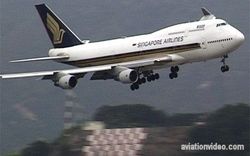Aero-Tips!
A good pilot is always learning -- how many times have you heard
this old standard throughout your flying career? There is no truer
statement in all of flying (well, with the possible exception of
"there are no old, bold pilots.")

Aero-News has called upon the expertise of Thomas P. Turner,
master CFI and all-around-good-guy, to bring our readers -- and us
-- daily tips to improve our skills as aviators. Some of them, you
may have heard before... but for each of us, there will also be
something we might never have considered before, or something that
didn't "stick" the way it should have the first time we memorized
it for the practical test.
Look for our daily Aero-Tips segments, coming each day to you
through the Aero-News Network.
Aero-Tips 08.30.06
 This
week's tragic departure crash of a commuter jet at Lexington, KY
reminds me of another horrible accident. On October 31, 2000 a
Singapore Airlines 747-400 was expediting departure in darkness and
high winds, at Taipei, Taiwan. A typhoon was bearing down on the
island nation and the seven-four's captain was trying to be the
last plane out before the storm hit. They didn't make it.
This
week's tragic departure crash of a commuter jet at Lexington, KY
reminds me of another horrible accident. On October 31, 2000 a
Singapore Airlines 747-400 was expediting departure in darkness and
high winds, at Taipei, Taiwan. A typhoon was bearing down on the
island nation and the seven-four's captain was trying to be the
last plane out before the storm hit. They didn't make it.
A passenger who survived the Singapore crash later said
she "enjoyed night takeoffs" because she loved to "watch the
runway edge lights speed by as the takeoff roll accelerated." But
she "didn't see any lights this time; it was dark as (she) looked
out (her) window while the plane raced down the runway." In
half-mile visibility the highly experienced aircrew had lined up on
the wrong runway-one that was not even lighted at the time, and was
closed for repairs. About 4500 feet into the takeoff roll the 747
struck a concrete barrier that tore into the racing jet. Nearly
half the people on board died in the ensuing crash.
Tunnel vision
Airline accident reporter and retired 747-400 captain Robert J.
Boser attributes the Singapore 006 crash to crew "tunnel vision" --
a pilot's impaired perception under stress that causes him/her to
mentally adjust what's seen to what the pilot *expects* to see.
It's the same phenomenon, he says, that causes a pilot to miss
hearing a loud landing gear warning horn, to turn to the reciprocal
of the desired heading and fly off in the wrong direction, or to
line up on the wrong runway or even the wrong airport for landing.
Pressure to take off ahead of the storm may have played a big part
in developing tunnel vision that resulted in this fateful
mistake.
Could tunnel vision have played a part in the Comair 5191 crash?
We don't know yet. Preliminary investigative statements are that
the crew and tower controller conversed normally before the
Canadair CRJ took the incorrect runway. Pilot fatigue is always
suspect for an early morning departure after an overnight crew
rest, and I'm sure this will be explored during the NTSB
investigation. To date, however, we know few additional
details.
Choosing the wrong runway may result in a collision with
obstacles on the runway, as in the Singapore 006 crash, or
inability to become airborne and a runway overrun, as with the
Comair jet this week. Lining up on the incorrect runway might lead
to a collision with another airplane on a crossing taxiway or, if
runways intersect, with an aircraft on a runway that's in use. In
tomorrow's Aero-Tips we'll discuss some techniques that may help
you avoid tunnel vision and line up on the proper runway.
Aero-tip of the day: Remember that even the
best of us are subject to tunnel vision at times. Take active
steps to line up with the proper runway for takeoff.
 Unfortunate... ANN/SportPlane Resource Guide Adds To Cautionary Advisories
Unfortunate... ANN/SportPlane Resource Guide Adds To Cautionary Advisories ANN FAQ: Turn On Post Notifications
ANN FAQ: Turn On Post Notifications ANN's Daily Aero-Term (04.29.24): Visual Approach Slope Indicator (VASI)
ANN's Daily Aero-Term (04.29.24): Visual Approach Slope Indicator (VASI) ANN's Daily Aero-Term (04.28.24): Airport Marking Aids
ANN's Daily Aero-Term (04.28.24): Airport Marking Aids ANN's Daily Aero-Linx (04.28.24)
ANN's Daily Aero-Linx (04.28.24)




